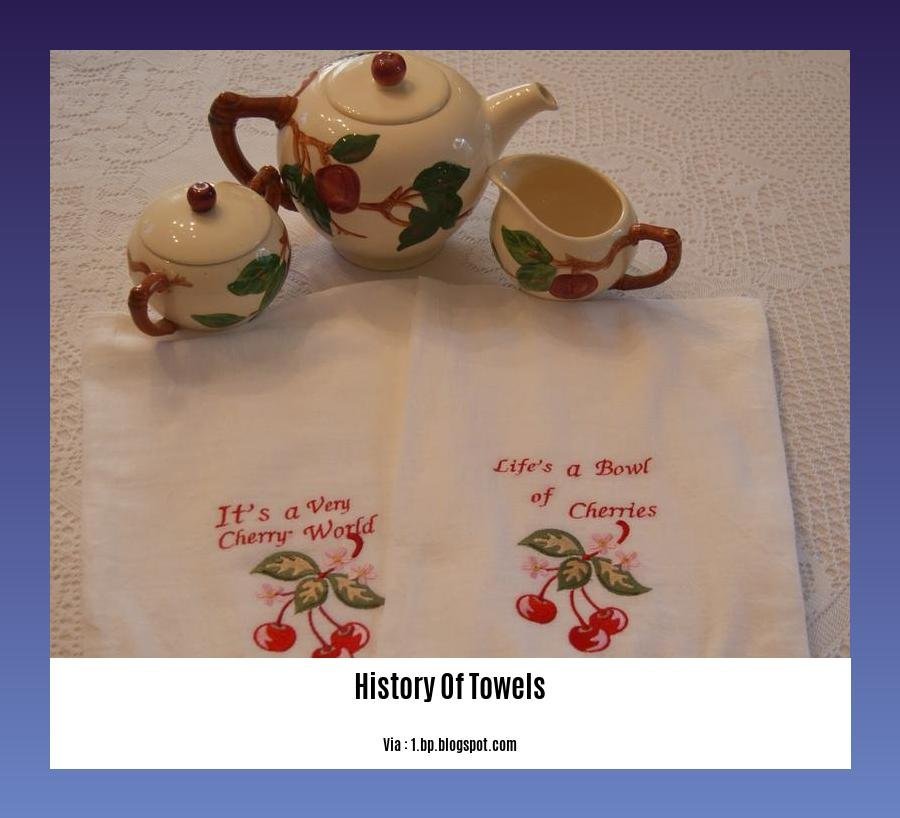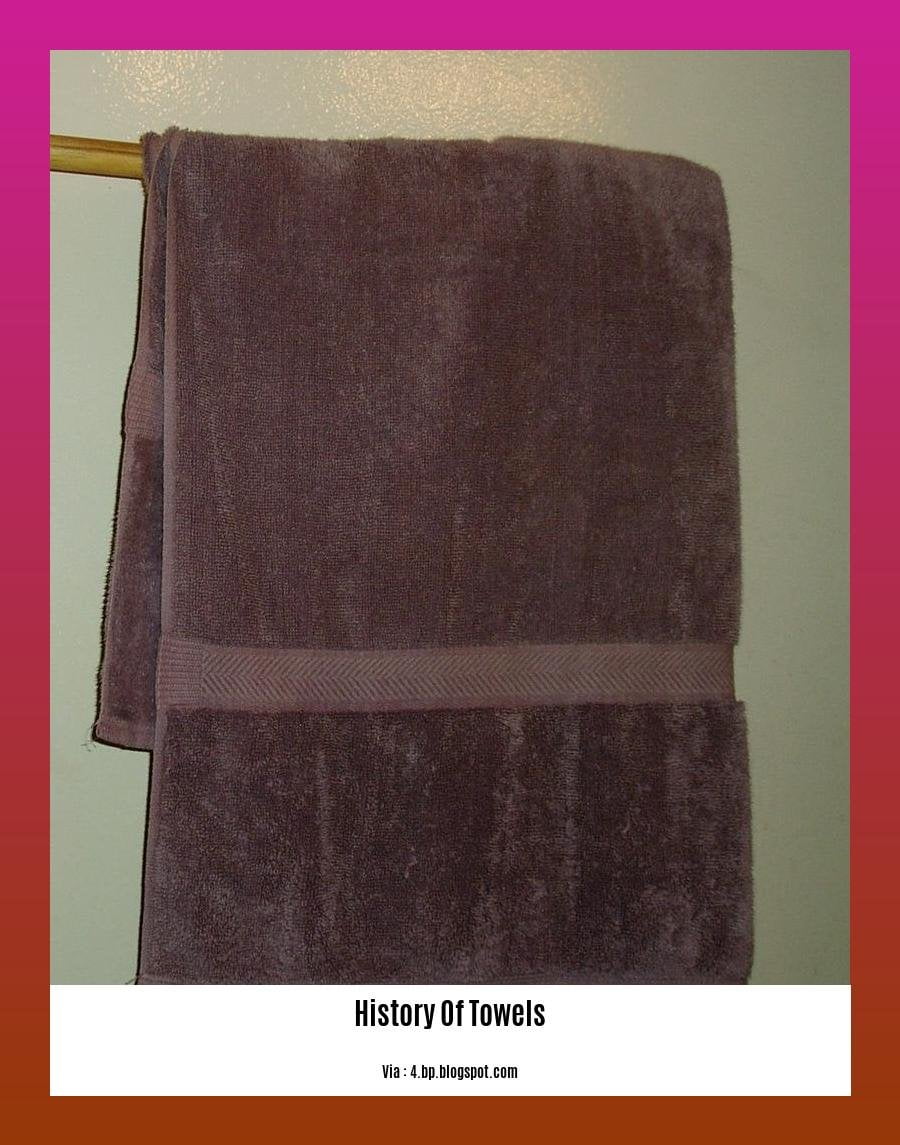In the tapestry of human history, even the most mundane objects hold stories waiting to be unraveled. [A History of Towels: Unraveling the Threads of Everyday Life] delves into the fascinating world of towels, tracing their evolution from humble beginnings to their current status as indispensable household items.
Key Takeaways:
- Towels are commonly associated with Bursa, Turkey, where they were first produced in the 15th or 17th century.
- The original towels were made of Turkish cotton or linen and were often hand-embroidered.
- These towels were initially used by brides during ceremonial bathing in Turkish hammams or bathhouses before their weddings.
History of Towels

Towels, those essential accessories that accompany us from the bathroom to the beach, have a history as rich and absorbent as the fabrics themselves. Let’s take a towel-worthy dive into their past:
A Woven Tapestry of Time
Towels, as we know them, originated in the 15th or 17th century in Bursa, Turkey, a city renowned for its textile artistry. Initially crafted from Turkish cotton or linen, these towels were often adorned with intricate hand embroidery, making them prized possessions, particularly among brides.
Bridal Rituals and Hammam Delights
Towels played a central role in traditional Turkish wedding ceremonies. Brides would use these beautifully embroidered towels during ceremonial bathing rituals in hammams, or bathhouses, before their weddings. These towels were not just for drying off; they symbolized purity, fertility, and the transition to a new stage in life.
Beyond the Hammam: A Global Journey
Towels soon transcended their ceremonial origins, becoming indispensable companions in everyday life. Sailors, travelers, and traders carried them across vast oceans, spreading their use to far-flung corners of the world. By the 19th century, towels had become a staple in homes across Europe and North America, evolving into the diverse forms we know today.
From Linen to Terry: An Evolution of Comfort
Early towels were primarily made from linen, known for its durability and absorbency. However, in the late 19th century, a new player entered the scene: terry cloth. With its superior softness and absorbency, terry cloth quickly became the preferred material for towels, revolutionizing the way we dry off.
Towels Today: A Symbol of Comfort and Care
Today, towels are ubiquitous, found in bathrooms, kitchens, beaches, and gyms worldwide. They come in a dazzling array of colors, patterns, and sizes, catering to every taste and purpose. From plush bath towels that envelop us in warmth to lightweight beach towels that dry us off under the sun, towels have become an integral part of our daily lives.
Towel Trivia
Did you know that the word “towel” is derived from the Old French word “toaille,” meaning “cloth” or “linen”?
The Guinness World Record for the longest towel ever produced measures an astonishing 82.27 kilometers (51.12 miles). It was created by the Pakistan Towel Manufacturers Association in 2017.
In some cultures, towels are considered a symbol of hospitality and are offered to guests as a gesture of welcome and comfort.
So, the next time you reach for a towel, take a moment to appreciate its rich history and the role it plays in our lives, weaving together comfort, tradition, and everyday rituals.
Uncover the harmonious journey of Tibetan singing bowls through the ages. Explore their ancient origins, cultural significance, and the secrets behind their mesmerizing sounds. history of tibetan singing bowls
Discover the fascinating evolution of Titleist drivers. From their humble beginnings to their position as a golfing legend, learn how these clubs have revolutionized the sport and continue to shape the game. history of titleist drivers
Towels in religious and cultural practices: Rituals, sacred uses, and symbolism

Towels. We use them every day, but have you ever stopped to think about their deeper significance? Towels are more than just a means of drying ourselves; they hold a special place in religious and cultural practices worldwide, representing rituals, sacred uses, and symbolism.
Towels in Religious and Cultural Practices
From ancient civilizations to modern-day rituals, towels have been an integral part of religious and cultural practices across the globe. Here’s a glimpse into their diverse roles:
Purification and Cleansing: Towels are often used for ritual cleansing before entering sacred spaces. In India, for instance, temples offer towels to visitors to purify themselves before entering the temple, symbolizing both cleanliness and devotion.
Sacred Objects: In many cultures, towels are considered sacred objects. In certain Native American tribes, for instance, towels are used to wrap sacred objects such as ceremonial pipes or drums, protecting them from harm and imbuing them with spiritual power.
Talismans and Amulets: In some cultures, towels serve as talismans or amulets, offering protection and good fortune. In ancient Egypt, towels were placed on the bodies of the deceased to protect them in the afterlife.
Symbolism of Hospitality: Towels are often used as a symbol of hospitality in many cultures. Offering a guest a towel is a gesture of welcome and comfort, signifying the host’s willingness to provide for their well-being.
Towels in Rituals and Ceremonies
Towels play a significant role in rituals and ceremonies, serving as a bridge between the sacred and the profane:
Baptism and Purification: In Christianity, towels are used in baptism ceremonies, symbolizing the cleansing of sins and the beginning of a new life in Christ.
Weddings: In many cultures, towels are used in wedding ceremonies to symbolize unity and purity. In traditional Jewish weddings, for instance, a towel is placed over the couple’s heads as a symbol of their bond and commitment.
Funerals and Mourning: Towels are also used in funerals and mourning rituals. In some cultures, towels are placed on the body of the deceased as a symbol of respect and to prepare them for their journey to the afterlife.
Symbolism and Rituals Across Cultures
The symbolism and rituals associated with towels vary widely across cultures, reflecting unique beliefs and traditions:
India: In India, towels are offered in temples to symbolize purity and devotion. They are also used in traditional Indian weddings, where the bride and groom exchange towels as a symbol of their union.
Japan: In Japan, towels are considered sacred objects, and a special type of towel called a “tenugui” is used in traditional tea ceremonies.
Native American Cultures: In Native American cultures, towels are used to wrap sacred objects, such as ceremonial pipes, to protect them and imbue them with spiritual power.
Key Takeaways:
- Towels hold a significant place in religious and cultural practices worldwide, representing rituals, sacred uses, and symbolism.
- They are used in rituals and ceremonies to symbolize purification, cleansing, unity, protection, and hospitality.
- The symbolism and rituals associated with towels vary across cultures, reflecting unique beliefs and traditions.
- Towels are more than just a means of drying ourselves; they are a powerful symbol of our connection to the sacred.
Relevant URL Sources:
[1] https://www.towel-manufacturer.com/the-symbolism-of-bath-towels-in-different-cultures#:~:text=Indian%20Rituals%3A%20In%20India%2C%20towels,spaces%2C%20symbolizing%20both%20cleanliness%20and%20devotion.
[2]
Exploring regional variations: Diverse towel types, patterns, and significance
Towels are not merely utilitarian pieces of fabric but also cultural artifacts that reflect the diverse traditions and aesthetics of regions worldwide. From the intricate patterns of Turkish Peshtemals to the vibrant colors of Mexican sarongs, towels come in a kaleidoscope of designs, each telling a unique story.
Turkish Peshtemals: A Woven Tapestry of History and Style
Turkish Peshtemals, with their distinctive flat-woven construction and vibrant stripes, are a testament to the rich textile traditions of Turkey. These lightweight and quick-drying towels, often adorned with intricate patterns and tassels, have been a staple in Turkish baths and households for centuries.
Mexican Sarongs: A Splash of Color and Versatility
In the vibrant land of Mexico, sarongs, known as “rebozos,” are not just beach essentials but versatile garments deeply embedded in the country’s cultural fabric. These colorful, fringed cloths serve as shawls, blankets, and even makeshift baby carriers, adding a touch of alegría to everyday life.
Japanese Tenugui: Simplicity and Symbolism
In the land of the rising sun, Tenuguis, simple yet elegant cloths made from cotton or linen, hold a special place in Japanese culture. These versatile towels, often adorned with auspicious symbols and designs, are used for various purposes, from wiping sweat during summer festivals to wrapping gifts and purifying sacred spaces.
Indian Gamchas: Multifaceted Utility and Ritual Significance
In India, Gamchas, versatile cotton towels with a checkered pattern, are an indispensable part of daily life. They serve as bath towels, turbans, and even prayer mats, reflecting the deep-rooted cultural and religious significance of textiles in Indian society.
Key Takeaways:
Towels come in a captivating array of designs, colors, and patterns, reflecting the diverse cultural heritage of different regions.
Turkish Peshtemals, with their intricate patterns and lightweight construction, embody the rich textile traditions of Turkey.
Mexican sarongs, known as rebozos, are a symbol of versatility, serving as shawls, blankets, and makeshift baby carriers.
Japanese Tenuguis, characterized by their simplicity and auspicious designs, hold a special place in Japanese culture and are used for various purposes.
Indian Gamchas, with their checkered pattern and multifunctional nature, are deeply ingrained in Indian daily life and religious practices.
Citations:
Towels and Their Cultural Significance
Technological Advancements: The Rise of Mass Production and Innovations in Towel Design
In the ever-evolving tapestry of human history, technological advancements have left an indubitable mark on diverse facets of our lives. The realm of textiles and everyday objects is no exception. Towels, those humble yet indispensable companions, have undergone a remarkable journey, intertwined with the march of technology.
The Loom’s Transformation
The advent of the Industrial Revolution heralded a new era for towel production. In the mid-18th century, the invention of the spinning jenny, flying shuttle, water frame, and power loom revolutionized the textile industry. These ingenious contraptions mechanized the spinning and weaving processes, enabling mass production of textiles at unprecedented speed and efficiency.
Towels Take Center Stage
The proliferation of textile mills fueled the demand for absorbent, durable fabrics like cotton and linen. Towels emerged as essential household items, transitioning from luxurious accessories to everyday necessities. Their popularity soared, becoming indispensable in bathrooms, kitchens, and beyond.
Embracing Innovation
The 20th century ushered in a plethora of innovations that further transformed towel design and production. Terry cloth, with its superior absorbency and plush texture, became the fabric of choice. The introduction of synthetic fibers like polyester and nylon offered new possibilities for durability, colorfastness, and affordability.
High-Tech Towels
Technological advancements continue to shape the evolution of towels. Today, we witness the rise of high-tech towels infused with antimicrobial properties, moisture-wicking capabilities, and even built-in sensors for tracking fitness metrics. These cutting-edge creations epitomize the convergence of technology and everyday objects, enhancing our well-being and convenience.
Key Takeaways:
The Industrial Revolution revolutionized towel production, enabling mass production and transforming towels into household necessities.
Terry cloth and synthetic fibers like polyester revolutionized towel design, offering superior absorbency, durability, and affordability.
Technological advancements continue to influence towel innovation, resulting in high-tech towels with antimicrobial properties, moisture-wicking capabilities, and fitness-tracking sensors.
Relevant URL Sources:
The History of Towels: From Ancient Origins to Modern Innovations
How Technology Has Changed the Textile Industry
FAQ
Q1: When were towels first made?
A1: The exact date of the invention of towels is uncertain, but historians believe towel-like objects made from natural materials were used as early as the 5th century BC.
Q2: What were the earliest towels made of?
A2: The earliest towels were made from natural materials such as linen, hemp, or cotton.
Q3: What were towels initially used for?
A3: Initially, towels were primarily used for religious and ceremonial purposes, such as bathing rituals and purification ceremonies.
Q4: How did towels evolve over time?
A4: Over time, towels became more widely used for personal hygiene and domestic purposes. The Industrial Revolution brought about technological advancements that allowed for mass production of towels, making them more accessible to the general population.
Q5: What are some different types of towels and their uses?
A5: Today, there are various types of towels designed for specific purposes, such as hand towels for drying hands, bath towels for drying the body after bathing, beach towels for drying off after swimming, and kitchen towels for wiping surfaces and utensils.
















